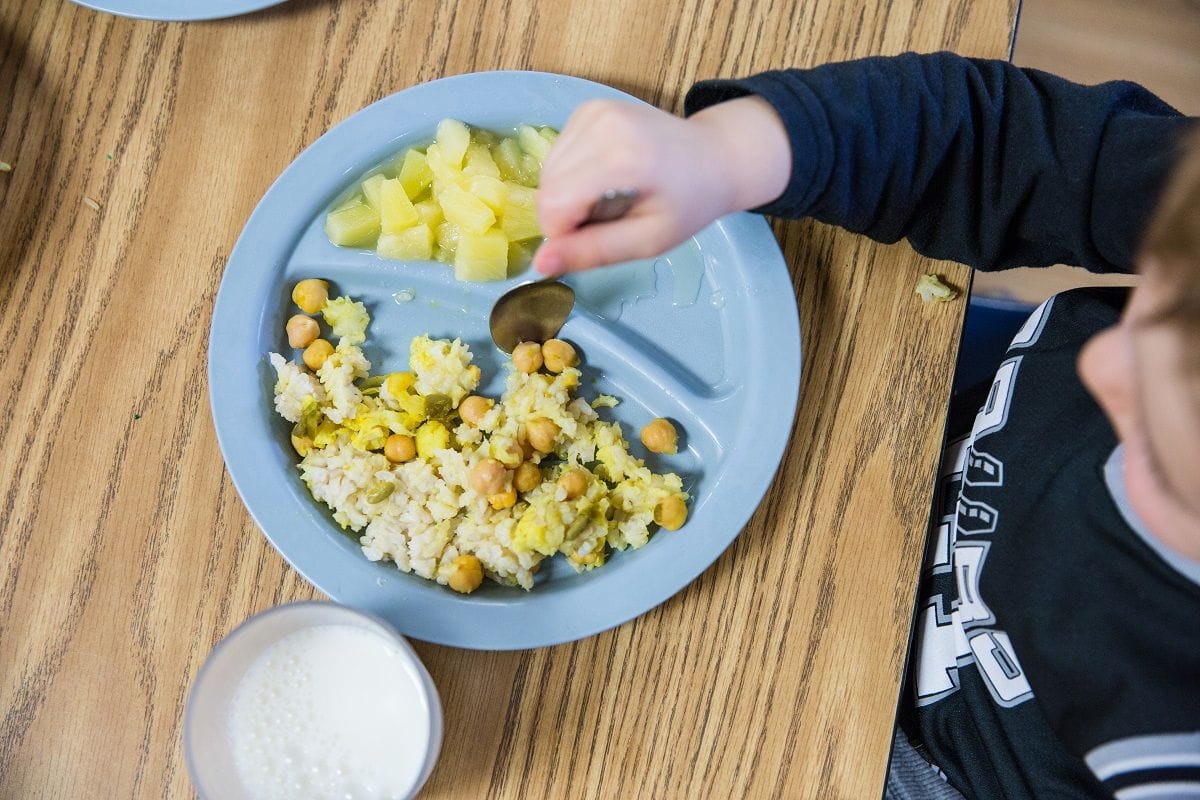Food-ventures! How We Get Even Picky Eaters to Try What's on Their Plates

By Carolyn Sweeney Hauck
Last year, KinderCare’s menu got a makeover. Out went the fried foods, the juice, and snacks like graham crackers. In came more whole grains, fresh fruits and veggies, and protein—and new, exciting dishes like Chinese lo mein, Indian biryani, and a Southwest-style brown rice-and-bean bowl delicately spiced with cumin and topped with salsa.
Why did KinderCare decide to add international foods (and new flavors) to its menus for young children? “We believe that encouraging children to try new foods is an important part of our Nutrition and Wellness program,” says KinderCare Nutritionist Courtney Hines. “Foods like lo mein and biryani also reflect the food many of our families in our 1,250 KinderCare centers eat at home.”
We also know that children’s bodies need the entire alphabet of vitamins and minerals to grow healthy and strong—and that means encouraging them to eat (and love) a variety of vegetables, fruits, grains, and proteins. By offering a wide range of good foods in our centers, we’re also encouraging young pizza lovers and chicken-finger fans to give new experiences and flavors a whirl. (That openness comes in handy when, say, families head to a grown-up restaurant or visit another family’s home for dinner.)
The Indian biryani dish we based our recipe on (which is full of aromatic spices like turmeric, clove, cardamom, and Garam masala) is a great way to open kids up to the different flavors used in another culture. Unless they’re of South Asian or Middle Eastern descent, most American kids (and adults) aren’t very familiar with this rice-based, flavorful meal. However, in South Asia and the Middle East, biryani is a famous dish served in nearly every home and restaurant. Kids in those regions might even call it comfort food!

Our vegetarian version of biryani calls for brown rice, chickpeas (a.k.a. garbanzo beans), and cauliflower. While a traditional biryani involves a LOT of spices, our dish features only a fraction of the spices to keep it friendly for developing palates—but we still keep it adventurous by adding ground ginger, turmeric, and Garam masala.
Finding just the right balance of spices and vegetables that a majority of our KinderCare kids will still find yummy (and that will also nourish growing bodies) was no small task—neither was introducing the dish to all of the centers across the country.
Opening their minds to a world of flavors
When we first introduced biryani to a KinderCare center in northern Virginia, one teacher couldn’t contain herself: “That’s my food!” exclaimed Sheba Hassain, a Pre-K teacher whose family emigrated from Pakistan. “Biryani is the food of my country and it was such an honor to get to share it with my friends at my center.”
That isn’t to say that all kids relish trying new foods at first—even in Hassain’s classroom. When she put the new dish in front of the kids, the reactions were a little mixed. “Some kids were really excited, and some kids were like, ‘Hmm, I don’t want to try it.’ But I sat with them and showed them how much I enjoyed it, and let them know it was my food, and then they got excited,” Hassain says. “Soon they were eating it and saying, ‘Yeah, Ms. Sheba, we like it!’”

So what does Hassain credit for helping ease kids into trying new dishes like biryani? KinderCare’s emphasis on family-style dining: “We cook meals for them, but we also sit with them and show them how to enjoy the food together,” Hassain continues. “It’s how we open their minds to new foods and experiences.”
In centers where teachers didn’t have a personal experience with biryani, the challenge of introducing the dish was greater, but they still rose to the occasion! One center got creative and served biryani for the first time during a dinosaur unit, and called the chickpeas “dinosaur food.” The children playfully devoured the biryani, not only sampling chickpeas for the first time, but the spices as well.
All of the work we do to ensure the foods are a hit pays off—sometimes with surprising results. “We had one child who never ate lunch at his center, but gobbled up the biryani,” says KinderCare’s Courtney Hines. “He and his family had recently emigrated from South Asia and, according to the teachers, seemed so happy to see a familiar food on his plate. We’ve also had many Latino and Asian staff members and families comment on how great it is to see their cultures reflected in our menu.”
And all of that, Hines notes, helps everyone in our centers feel that they truly belong.

Home Guide to Trying New Foods
After a long day of working and parenting, the last thing you probably want to deal with at dinnertime is your child’s frowny face as she stares down at a new veggie on her plate. Fear not—our tried-and-true method for getting kids to try something new really works! Our teachers swear by it. Here’s how to do it:
1. Talk About It with Enthusiasm!
Introduce a new food with real excitement about why it’s good and what it does to make you grow big and strong. As Center Director Tanya McKinzie points out, “Our teachers sit and talk with kids about the food they’re eating, and that makes a world of difference.” Stir in friendship, and you’ve got the recipe for an adventurous eater. McKinzie continues, “Kids get excited about trying new foods, especially when they see their friends enjoying it.” At home, you could try introducing a new dish or food during a playdate (a dish you know his friend likes, of course).
2. “Just One Bite.”
Ask them to try just one bite—just one. Even better, make it an at-home rule! We find more often than not, our kids end up liking something that they weren’t sure about at the beginning of the meal.
3. Keep at It!
We tend to not stop at “no,” but if they’re absolutely refusing to eat just one bite, we don’t press it right away. After all, their little taste buds are developing and their palates are changing, so what they won’t eat one week, they might like a few months down the road. As McKinzie says, “You have to serve a dish again and again—and they’ll probably end up liking it on the 15th try.”




